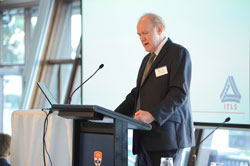Opinion Pieces: since 2007, Prof. David Hensher has written an opinion column in the Australasian Bus and Coach magazine, where he monthly discusses a lot of different transport-related hot topics. In this section we are revisiting these columns.
Octuber 2012
Crowding in public transport is becoming a growing concern as demand grows at a rate that is outstripping available capacity. But what do we mean by crowding? There are five major metropolitan rail systems in Australia and each has their own measure of crowding. For example, Sydney’s CityRail uses the number of standing passengers per square metre to measure crowding, and its benchmark is 1.9 standees per m². An alternative crowding measure for CityRail is load factor (passengers per seat), and the corresponding target set by the Minister in the Rail Services Contract is no more than five percent higher than 135 percent of seat capacity during the peak hours. Melbourne uses the rolling hour average loads to measure crowding in its Metro trains, and if the number of average passengers per train during a given hour, as counted at the Melbourne city cordon, exceeds 798, a railway line is considered overcrowded. For Queensland Rail, the target of the length of standing time is no more than 20 minutes.
Regardless of formal definitions, it is often the perceptions of travellers that determine whether crowding is a concern or not. In the September 2012 quarter of the ITLS Transport Opinion Survey (TOPS), we asked about train crowding: “How would you describe the level of crowding on your local train services in the peak hours: tolerable, or intolerable? And, what percentage of the time on the train during peak times do you typically have to stand __%?”
Overall, 43% of Australian rail users said that crowding on train services is intolerable. 53% of rail users in Victoria said that crowding on train services is intolerable, which is the worst amongst all states; while 68% of Queensland rail users said that crowding on train services is tolerable.

20.5% train users reported that they spent 80%-100% of time standing on the train when travelling during peak hours.

The response in many cities is to propose more rail investment to reduce the amount of crowding. While this has some merit, a close look at some of the crowding locations raises questions as to why are we not considering the role of long haul bus services in relieving some of this pressure? There are very real opportunities here to start investing in bus rapid transit (BRT) as a way of taking pressure of the rail network while growing public transport patronage. The costs will be much lower per passenger carried that heavy rail. Sadly BRT hardly gets considered in Australia (the exception being Brisbane) and hopefully the Northern Beaches of Sydney. What is disturbing however is the failure of government and other agencies to recognize and promote the virtues of BRT. The ITLS TOPS September 2012 survey found that only 8% of Australians correctly described BRT as ‘dedicated corridor buses’ or a similar phrase; 14% of Australians said ‘never heard of it’, and 32% did not know what it is. 13% of NSW residents described BRT as ‘dedicated corridor buses’, better than other states. What is surprising is that Queensland which has a very successful Busway network in Brisbane appears less informed than NSW and Vic.
Food for thought
¿Comments? ¿Opinions? ¿Similar News? Send them to us!













